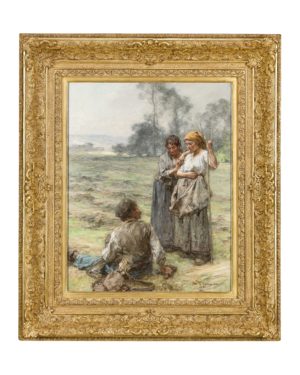Largely considered the first modern movement in art history, 19th-century French Realism reflects the revolutionary attitudes of its age. Based on a doctrine of french painting subjects as they genuinely lived, the Realists captured in gritty detail the present-day existence of humble, everyday people and sought to convey a truthful vision of their age. This time period produced an impressive amount of famous fine art paintings which are highly sought after to this day. For Realist artists, working class subjects became conduits for their initiative to reject idealization and create art based on direct observation of the world
“Painting is an essentially concrete art and can only consist in the representation of real and existing things” -Gustave Courbet, 1861

Up until the 1840s, Western European arts was dominated by idealistic attitudes. Known as Romanticism, this French art was imbued with emotion, glorification, and sometimes even fantasy. Seen through the large canvases of Romantic virtuosos Eugene Delacroix and Theodore Gericault, art was graced with larger-than-life legendary political figures and historical allegories, emphasizing intense emotion and grand aesthetic experiences.

By the mid 19th-century, the Realists, largely pioneered by Gustave Courbet, sought to reject this traditional form of idealization, deeming it as outmoded. In the wake of the Enlightenment and Industrial Revolution, rationality and reform was the order of the day, and the artists during the realist movement sought to approach their canvases in a similarly rational way.
It's important to note that the Realist movement was inundated with a particularly political consciousness. Emerging in France in the aftermath of the 1848 Revolution, the realism movement developed out of Napoleon III's Second Empire. All the while, there was a general politicization of life, and French society was fighting for dramatic reform. In an effort to guide these societal desires, Realists sought to democratize French art with their depictions of their modern subjects and the working class, reflecting their desire for a more democratic and egalitarian French society.
Embodied by the writings of Émile Zola, rationality and democratization was quickly becoming a central social theme. It would be Courbet’s revolutionary work, The Stonebreakers, that set the tone for democratization in the fine arts. With this central masterpiece, Courbet opened the door to depicting peasantry and rural workers, challenging the primacy of the long favored style of idealization.

A devotion to the portrayal of real-life subjects is undeniable in the works of French Realist artist Leon Augustin Lhermitte. Unquestionably influenced by Courbet and Jean-François Millet, his works pay tribute to the working class rural peasantry. His work Foins, Faucheur et Deux Femmes reflects the Realist's strict adherence to portrayal of real life: two rural women, each with their own individual character, stand before a resting hay gleaner on an expanse of a tranquil green landscape. Rich, earthy tones cover the canvas and a level of clear meaning is disclosed to the viewer. Possessing a remarkable talent of reflection of everyday life, the composition is a clear reflection of Millet's foundational work, The Gleaners, that sought to portray everyday working class people in a similar manner to other social classes. This 19th century french painter beautifully captures realist art by portraying everyday subjects in rural life settings in each landscape painting he creates.
Realist art is broadly considered the beginning of modern art, largely because its principle lies in the fact that everyday life and the modern world were now considered suitable subjects. In the years after this modern life paintings reached its heyday, it is still celebrated as a pivotal point in European art history, combining both stylistic changes and political temperament of the time.
Modern art, cinema, and literature were all influenced by the French realism movement and is one of the most defining moments in history today. If you are considering adding a modern realism painting to your art collection, Rau Antiques is an excellent place to begin. Bring home a piece of this art realism movement today by reviewing our selection of nineteenth century realist art right on our website.
|
|




